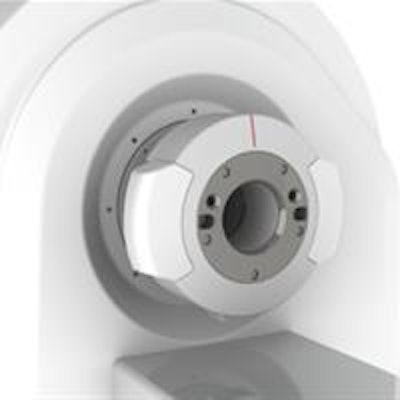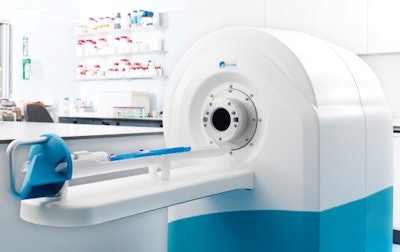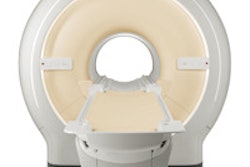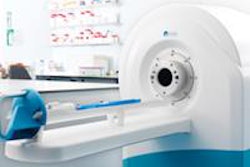
Preclinical imaging is an increasingly vital research tool for observing organ, tissue, cell, or even molecular changes, and is often used while animals respond to physiological or environmental stimuli. Recent advances in preclinical MRI scanning technologies have escalated the quality and extent of preclinical research that can now be undertaken by university and industry researchers, as well as lowering the cost of new equipment.
 MR Solutions has developed the world's first range of commercial, preclinical, cryogen-free benchtop MRI systems.
MR Solutions has developed the world's first range of commercial, preclinical, cryogen-free benchtop MRI systems.In 2012, the first commercial cryogen-free, 3-tesla benchtop MRI scanner was launched into the preclinical market by U.K. manufacturer MR Solutions. Due to the scanner's portability -- and an inbuilt Faraday cage that eliminates the need to house it in a separate metal-lined room -- the new system can be easily installed in existing Class 3 and 4 laboratories.
New magnet technology
The enabling breakthrough was the development of superconducting magnet technology that does not require cryogenic fluid for cooling. Earlier magnets were cooled using liquid helium, which requires a bulky and heavy mechanical structure. As these bulky helium cooling systems are no longer necessary, equipment can be much smaller and portable, simplifying procedures and installation costs. This also represents an important step forward for medical and scientific communities dealing with the shortage and expense of helium.
All of these changes were possible due to MR Solutions' collaboration with a magnet partner to eliminate the liquid helium cooling system by using a novel magnet design incorporating superconducting wire. This enables the use of a standard low-temperature cryocooler (fridge) to cool the magnet to the 4° K (-269° C) that's necessary to achieve superconductivity.
Prior to the development of cryogen-free 3-tesla MRI technology, scanners could not be placed near to other imaging devices due to the strong magnetic field created by the MRI system, which can damage sensitive equipment. The elimination of the helium cooling system has allowed the optimum installation of an additional solenoid, which counters the stray magnetic field.
This results in a stray magnetic field that only extends a few centimeters and does not affect or interfere with nearby laboratory equipment. The cryogen-free MRI can therefore be used safely in close proximity to other imaging modalities, such as x-ray CT, PET, and SPECT.
Industry developments
The latest developments include MR Solutions' launch of a cryogen-free 7-tesla preclinical scanner with a bore diameter of 17 cm. The magnet in this scanner has an elliptical field-of-view that makes it better suited for body imaging, and particularly suited to the animal's shape. One powerful new feature facilitated by the magnet technology is the ability to vary the magnetic field from 0 to 7 tesla, making new research applications possible, particularly in the development of contrast agents.
 The cryogen-free MRI system fitted with a clip on SPECT camera.
The cryogen-free MRI system fitted with a clip on SPECT camera.Another recent trend is the introduction of multimodality systems, which enable researchers to use various anatomical and molecular scanning technologies -- including MRI, SPECT, PET, optical, and CT scanning -- in conjunction with each other to obtain different results simultaneously.
For many preclinical studies, researchers need to employ different imaging techniques to visualize the various changes that may occur, for example, as a result of a drug being tested. Having to move animals between different scanners in separate locations means that they must be reanesthetized, which can alter the results.
Reducing this need to move animals from one machine to another enables far more in-depth research to be carried out faster, more easily, and at lower cost than before, including rapid analysis of the feasibility of prospective research projects.
The combination of high-resolution PET or SPECT with high-performance cryogen-free MRI instrumentation should provide significant benefits for both academia and industry. Such systems offer researchers simultaneous multimodality imaging that has not been commercially available before.
To provide 3D SPECT images, MR Solutions has devised a system whereby four gamma camera heads and focusing collimators can be easily clipped on to the front of the MRI scanner bore. The SPECT images can be registered with the MR images to provide combined anatomical-functional information. The SPECT gamma camera can also be used independently.
PET capability is provided by solid-state detectors and FPGA technology incorporated within the bore of the MRI scanner. This approach combines the detailed structural and functional tissue characterization provided by the MRI scan with the extreme sensitivity of PET imaging for metabolism and tracking of uniquely labeled cell types or cell receptors. This feature is particularly useful in oncology, cardiology, and neurology research.
Ongoing development
MR Solutions, which is based in Guildford, Surrey, has a pipeline of new multimodality innovations under development. It already produces 3-tesla MRI preclinical imaging systems with bore sizes of 17 cm and 31 cm, enabling small- to medium-sized animals to be scanned. And following the recent launch of its 7-tesla scanner with a 17 cm bore width, the company plans to also introduce larger bore sizes on this system.
MRI technology itself, through hyperpolarization (which increases the signal for short periods of time to enhance imaging ability) and other techniques, is able to provide a much wider range of capabilities than traditional MRI equipment.
The MRI technology now available is transforming the way that researchers can work, with much more complex projects and greater imaging ability. With equipment now more affordable and room adaptions no longer necessary, preclinical MRI systems with multimodality capabilities will become more widely available.
David Taylor is the CEO at MR Solutions, which evolved from MR Research, founded by Taylor in 1999.
© IOP Publishing Limited. Republished with permission from medicalphysicsweb, a community website covering fundamental research and emerging technologies in medical imaging and radiation therapy.



















